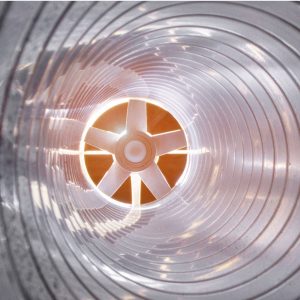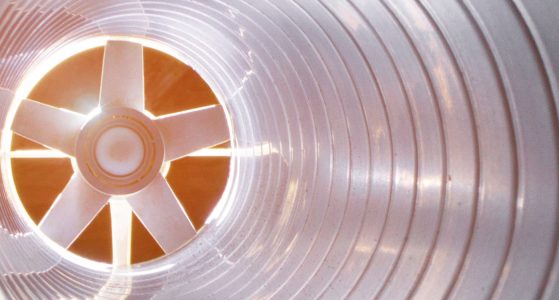UV light for HVAC systems is proven to improve indoor air quality and help to achieve peak performance from HVAC units. Heating, venting, and cooling (HVAC) systems can easily become polluted with harmful microorganisms, particularly bacteria, fungi, and other particulates in the air. This causes a build-up of contaminants in air handling units (AHU) and can reduce performance, energy efficiency and effectiveness in circulating clean air. HVAC units equipped with the proper filtration and disinfection methods maintain optimum performance and provide the best indoor air quality (IAQ).
Do UV Lights in HVAC Units Really Work?
Many people want to know if using UV lights in HVAC units really works to disinfect and improve indoor air quality. The answer is yes, although the right types of UVC lamps for HVAC units must be utilized and installed by a professional to achieve maximum air disinfection. With the right lamps and correct installation, UV lamps are proven effective at killing bacteria, viruses, mold, and fungi, particularly on internal components such as heat transfer coils which are particularly vulnerable to contamination due to the condensation that can form.
UV light for HVAC systems is also effective at preventing mold build-up in ducts and inactivating mold spores when passing through ductwork. Ozone disinfecting lamps also reach places that direct exposure to UVC lamps cannot reach and effectively eliminate foul odors and volatile organic compounds (VOCs) from the air.
UV Lights for HVAC: Proven in Hospitals, Offices, and Schools
UV lights in HVAC systems improve air quality in any environment and are becoming more popular in many applications from residential, to commercial and industrial. UV light disinfection has long been used in the medical field, in hospitals, and in surgical operations. UV light in upper room air handling units is approved by the Centers for Disease Control and Prevention, CDC, in treating tuberculosis (TB), with the CDC offering guidelines for healthcare settings (CDC, 1) for the environmental control of tuberculosis (TB) bacteria. Upper-room UVGI systems have been used for decades to kill or inactivate airborne TB as an effective and safe method of UV air treatment.
Additional studies have been conducted in office buildings and schools to document the benefit of UV light for HVAC systems in various environments. A study by the National Institutes of Health in August of 2001, (NIH, 2) focuses on the effectiveness of UVGI in reducing fungal contamination and the benefit of significantly reducing various types of fungi found within HVAC units on a multilevel office building. The study included taking air samples and insulation samples from various floors of the 286,000 ft.² office building each equipped with their own air handling units, with one floor designated as a control floor and the other a study floor equipped with UV lights in the HVAC AHUs.
Various types of fungi were found in both air and insulation samples prior to UV germicidal irradiation (UVGI) and included Aspergillus versicolor, Penicillium corylophyllum, and a strain of an unidentified Cladosporium species. The study concluded that UVGI was effective at reducing fungal contamination showing significantly lower levels of viable and total airborne fungi from samples taken during periods of UV exposure.
Another well-known study was published by the National Institutes of Health by Dick Menzies, et al, (NIH, 3) and examined the use of UV light in office HVAC systems and the benefits provided to the worker’s health. The study focused on unexplained work-related illnesses or symptoms of workers and whether UVGI in drip pans and cooling coils of ventilation systems would improve workers’ symptoms by reducing microbial contamination of the HVAC system. Findings showed a reduction of microbial and endotoxin concentrations on treated, irradiated surfaces of 99% and was associated with significantly fewer work-related symptoms overall.
The American Society of Heating, Refrigerating, and Air-Conditioning Engineers, ASHRAE, is a respected and diverse organization with participation from over 132 nations and more than 50,000 members. ASHRAE is focused on advancing the science and art of heating, ventilation, refrigeration and air conditioning to promote a sustainable world and to serve humanity. ASHRAE (ASHRAE, 4) offers several resources for HVAC filtration and disinfection, including the proper design, engineering and installation of:
- UV light for HVAC applications
- UVC in duct air disinfection
- UVC for upper room disinfection
- UVC in duct surface disinfection
- UVC portable room decontamination
Additional research by ASHRAE and Penn State University (Bahnfleth, 5) details the history, fundamentals, equipment, and system design principles of UVGI applied to HVAC systems. According to this publication, UVGI was tested in schools in Philadelphia in 1942 with successful results in reducing rates of infection. Several studies are referred to in this joint project with ASHRAE and Penn State University citing improvements in children with mold-induced asthma and a reduction in fungi in air handling units. Additional information includes guidelines for UVGI equipment, lamp design, and the importance of ballast selection on lamp performance.
LightSources Offers UV Lights for HVAC Disinfection
LightSources is a world-leading supplier of high-tech UV germicidal lamps designed for maximum strength and long-lasting life to meet the needs of any UV germicidal requirement. Our lamps can be found in UV treatment systems for water, surface, and air disinfection applications worldwide. We design, engineer, and manufacture high-quality germicidal UVC lamps with one of the widest selections of UVG germicidal lamp solutions as well as offering custom-designed solutions.
Our lighting engineers offer prototype design solutions to meet your needs, with custom phosphor blends and a deep understanding of UV radiation to meet your germicidal requirements. We can help you determine the best UV lamp design and implementation for your application and environment. UVGI in HVAC units prevents mold and fungi build up and dispersal and is beneficial in both furnaces and air conditioning units as well as in HVAC ducts.
LAMP PRODUCT DATA:
UV Germicidal LampsLAMP Applications:
UV Germicidal ApplicationsLightSources is an industry leading worldwide supplier of UV lamp solutions including germicidal UVC lamps found in disinfection systems worldwide. We offer high-tech, high-quality, long-lasting germicidal lamps for water, surface and air treatment systems. Contact an engineer today to learn more about our germicidal UVC lamp solutions including UV lights for HVAC systems.
Resources:
1. Centers for Disease Control and Prevention, Environmental Control for Tuberculosis: Basic Upper-Room Ultraviolet Germicidal Irradiation Guidelines for Healthcare Settings, https://www.cdc.gov/niosh/docs/2009-105/default.html
2. NIH, (2001 August), Effectiveness of Germicidal UV Radiation for Reducing Fungal Contamination within Air-Handling Units, https://www.ncbi.nlm.nih.gov/pmc/articles/PMC93076/
3. NIH, (2003 November) Effect of ultraviolet germicidal lights installed in office ventilation systems on workers’ health and wellbeing: double-blind multiple crossover trial, https://pubmed.ncbi.nlm.nih.gov/14654316/
4. American Society of Heating, Refrigerating and Air-Conditioning Engineers, ASHRAE, https://www.ashrae.org/technical-resources/filtration-disinfection
5. Bahnfleth, AHSRAE, et al, Fundamentals of Ultraviolet Germicidal Irradiation for Air and Surface Disinfection, https://www.ashrae.org//File%20Library/Professional%20Development/Learning%20Portal/Instructor-Led%20Training/Online%20Instructor-Led/FINAL_UVGI-Online-Course-September-9-2020.pdf


